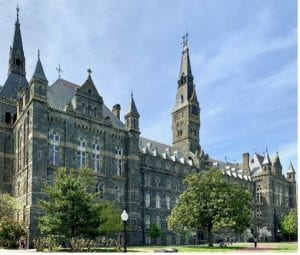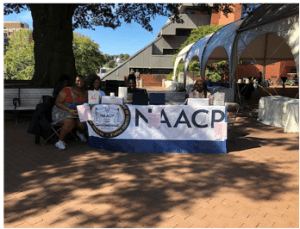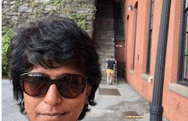About Rachel’s Fullbright Blog Series; Rachel Simon-Kumar was awarded the NZ Fulbright Scholar Award for 2022 and will be at Georgetown University, Washington D.C, between October 2022 and February 2023. During this time, she will be hosted at the Department of Women’s and Gender Studies, working with Prof. Nadia Brown. She will exploring comparative perspectives on intersectionality among Ethnic Minority Women in Politics in New Zealand and the United States. Her occasional blogs will reflect on gender, race and politics during her Fulbright journey.
I will start my Fulbright blog with a photo of the Potomac river on my walk to Georgetown my first day in Washington DC.
Looking over the bridge at the seemingly unending ribbon of cobalt blue, my first impression was of the ‘mighty Waikato’ and home in Kirikiriroa/Hamilton, a touchstone of belonging for me in Aotearoa New Zealand. Where there is a river, there is a call to home.


The Potomac (pronounced ‘po-tah-mic’) is the anglicization of the Native American term for great trading place” or “place where people trade.” The river was also the line that separated the Union army from the Confederacy during the American Civil War with Washington DC on one side and Virginia on the other (all this thanks to Wikipedia).
Given this history, it seems almost fitting that the bridge that links the two states is named after Francis Scott Key bridge (or just the Key Bridge), the author of the American National Anthem “The Star Spangled Banner”. Over the bridge, you walk into Georgetown, distinctive for being DC’s ‘character neighbourhood’ with tree-lined cobblestone streets, historic buildings, clusters of boutique shopping outlets, and the strategic location for many Embassies. In fact, the first building that caught my attention was the Ukrainian Embassy.
Georgetown university’s main campus is located at the end of ‘O Street’. A walk up a short flight of steps from the main gates and you cannot miss Healy Hall, the gothic architecture-themed main building at the centre of the lawns. A colleague referred to it as the ‘Harry Potter building’, and certainly there are unmistakable similarities! (the picture below is from an online source as my phone camera couldn’t quite capture the entire building).

Speaking of iconic buildings, I have an office in what is called ‘the Car Barn’; here is a link to a brief history. The Car Barn houses departments such as American Government, International
Relations (where I’m seated), the Office of Global Services. History aside – and this would be of interest to film buffs – the flight of steps alongside the Car Barn are called the Exorcist steps. Apparently a really scary scene from the film was shot here – I wouldn’t know as I haven’t seen it (and wouldn’t for a million $$). There were some rumours floating around about not walking down the steps/up the steps – in any case, to be on the safe side, I’ve decided to avoid the steps altogether 😊
Georgetown, as you can imagine, has given rise to eminent world leaders, diplomats, scholars, and authors. I spotted some well-tailored gentlemen on campus whispering into their earpieces and was told that they were security for someone prominent who happened to be visiting. In the time I’ve been there, Transport Secretary Pete Buttigieg spoke on campus and former Vice President Mike Pence is due soon.
My first fortnight here in DC has been a mixture of newness (traffic on the right (wrong for me) side, streets named by numbers and alphabets, the ubiquity of creamers in place of milk, the practice of tipping, the idea of University mascots, Halloween frenzy, the coffee that just isn’t quite what I’m used to in New Zealand, and so on) and of familiarity, especially in the buzz and rhythm of campus life.


Gender and Race Politics on campus
Georgetown, like several other universities around the world, has been looking into its own history of racism. The GU272-Jesuit Diaspora project acknowledges the enslavement and subsequent sale of 272 people owned by the Jesuit order of the university in 1838 in order to invest in the capital development of the university. In reparation, the university is now tracing their descendants, reconnecting families, participating in healing, and offering educational and other opportunities to them. For more on this, see https://www.gu272.net/partners.
On the gender front, somewhat coincidentally – and especially relevant to EWP – Madeleine Albright was featured on campus the week I arrived. Albright, who passed away earlier this year, in her role as Secretary of State, was prominent in the 1990s pushing the agenda of reproductive rights on the world stage. She led the US mission to the 1995 United Nations Beijing Conference for Women. She, along with other feminists activists, scholars and leaders, formed the intellectual backdrop to my PhD thesis on ‘Reproductive Health and Policy’ in India which I was writing at the time.

The central quad area in Georgetown where students gather is surprisingly called ‘Red Square’. At lunch time it tends to be festooned with stalls promoting various political groups and cultural ass. I had a chat with students at the NAACP (National Action for the Advancement of Coloured People) noting that their stall was ‘manned’ entirely by women. They agreed with me without surprise. Perhaps it isn’t an anomaly but part of the emerging trend of politics for women of colour.

I have permission from the young women below to post this photo with their images
Women of colour are a tour de force in contemporary American politics. According to a 2019 report by the AAPI Civic Engagement & Groundswell groups, “[s]ince 2008, the population of women of color has increased by 18% while their voter registration rates have jumped by 25%, thus contributing to the changing makeup of the American electorate” (pg. 3). Women of colour are highly likely to mobilise their family and friends to vote and more likely to participate in grassroots activism. They also tend to vote Democrats.
In just the last decade, there has been historic increases of women of colour as elected members at most levels of government: Vice-President, Cabinet, Congress, Senate, and state legislatures. Despite these achievements, they are still underrepresented proportional to their population numbers and policy representation of their interests lags well behind (CAWP, 2019)
References
AAPI Civic Engagement Fund. (2018). Ahead of the Majority: Foregrounding Women of Color. AAPI Civic Engagement Fund.
Centre for American Woman in Politics (CAWP). (2019). Black Women in American Politics. Centre for American Woman in Politics (Rugters University).
Dittmar, K., Sanbonmatsu, K., Carroll, S. J., Walsh, D., & Wineinger, C. (2017). WOMEN IN THE U.S. CONGRESS (p. 56). Center for American Women and Politics, Eagleton Institute of Politics, Rutgers University.

Recent Comments